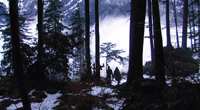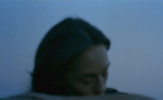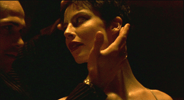 A Lake, 2008. With a Russian cast, minimal French dialogue, and geographically ambiguous setting, Philippe Grandrieux’s A Lake (Un Lac), like his multilingual preceding film, La Vie nouvelle, expounds on the notion of a borderless cinema – one that not only dismantles the man-made frontiers between nations and cultures, but also the boundaries between image and sound, material and light, logic and instinct. And like the indeterminate chronology of La Vie nouvelle, A Lake also takes place in a hermetic environment that seems equally primordial and post-apocalyptic, where human interaction is reduced to its essence: a knowing glance, a comforting touch, a frenzied exertion, an anguished cry.
A Lake, 2008. With a Russian cast, minimal French dialogue, and geographically ambiguous setting, Philippe Grandrieux’s A Lake (Un Lac), like his multilingual preceding film, La Vie nouvelle, expounds on the notion of a borderless cinema – one that not only dismantles the man-made frontiers between nations and cultures, but also the boundaries between image and sound, material and light, logic and instinct. And like the indeterminate chronology of La Vie nouvelle, A Lake also takes place in a hermetic environment that seems equally primordial and post-apocalyptic, where human interaction is reduced to its essence: a knowing glance, a comforting touch, a frenzied exertion, an anguished cry.
In A Lake, the figurative Garden of Eden is a barren, winter forest shrouded in mist where a lumberjack, Alexi (Dmitry Kubasov) lives in a remote cabin near a lake. Prone to increasingly frequent bouts of epilepsy, Alexi’s trips to the woods are as much a necessary ritual for survival as it is a rugged communion with nature, often ending up burrowed by convulsions into the snow until the seizure passes and he is able to walk home. There are other members in the household – a blind mother, Liv (Simona Huelsemann), a returning father, Christian (Vitaly Kishchenko), a younger brother, Johannes (Artur Semay) – but they all remain in the periphery, drifting in an out of his searching gaze, and only his sister and soul mate, Hege (Natalie Rehorova) can penetrate his frustration and despair over a body that continues to betray him. It is a lonely, if reassuring and predictable existence until a stranger, Jurgen (Alexei Solonchev) comes into their lives and, like the felled trees in the forest, momentarily, but irreparably, disturbs their fragile paradise.
Loosely reminiscent of Aleksandr Sokurov’s Mother and Son in its invocation of Caspar David Friedrich’s gothic landscapes to convey a sense of profound isolation, intimacy, and longing, A Lake, nevertheless, remains very much a Grandrieux film, bearing his singular imagery of synaptic, perturbating camerawork, defocused framing, and liminal compositions that transform everyday movements and rhythms into a frisson of textured, abstract impulses that feed the senses. Eschewing the moral ambiguity and transgressive nature of his earlier films, A Lake also represents an aesthetic shift in Grandrieux’s cinema towards the idea of nature as integral character: a transition that is implied in Alexi’s recitation of a passage about the unity of the soul between man and beast, as well as his lack of dominion over the ephemeral forces of nature. It is this image of humanity receding into the environment that ultimately creates the visceral poetry of A Lake, capturing the body as landscape in all its gestures and paroxysms, contours and spaces, violence and ecstasy.
[First posted on AFI Fest Daily News, 10/01/09]
*****
 Sombre, 1998. While I’m not at all enraptured by the murky, elliptically fractured, and characteristically amoral transgressive cinema of Philippe Grandrieux, I also cannot help but be drawn to certain aspects of his filmmaking that I find undeniably sublime in the sensorial purity of their realization. One such moment occurs in an early episode in Grandrieux’s debut feature film, Sombre: an eerily silent shot of Jean (Marc Barbé) looking away from the camera at a vacant lot (a recurring image of the back of his head that prefigures the psychological ambiguity and enigmatic motivation of Olivier in Jean Pierre and Luc Dardenne’s The Son) juxtaposed against the crashing waves of a turbulent stream. The seemingly unstable, unfocused image drifts into and out of frame, intermittently revealing the outline of a female form lying violated and lifeless near his feet. Grandrieux’s introduction to Jean is also ingeniously conceived – a disorienting tracking shot of a lone automobile on a dark, tortuous road set against the foreboding, ambient, mechanical drone of an engine that cuts to the sound of children screaming as they watch a puppet play at a guignol, where Jean, uncoincidentally, performs as a puppeteer. This introductory image of primal reaction, instinctive terror, manipulative control, and possession compactly (and evocatively) sets the tone for the film’s thematically (and visually) dark tale of impossible love as the restless Jean carves a violent path of sexual encounters – and serial murder victims – until a virginal, stranded motorist named Claire (Elina Löwensohn) momentarily offers him a glimpse of the possibility of intimacy and complete love.
Sombre, 1998. While I’m not at all enraptured by the murky, elliptically fractured, and characteristically amoral transgressive cinema of Philippe Grandrieux, I also cannot help but be drawn to certain aspects of his filmmaking that I find undeniably sublime in the sensorial purity of their realization. One such moment occurs in an early episode in Grandrieux’s debut feature film, Sombre: an eerily silent shot of Jean (Marc Barbé) looking away from the camera at a vacant lot (a recurring image of the back of his head that prefigures the psychological ambiguity and enigmatic motivation of Olivier in Jean Pierre and Luc Dardenne’s The Son) juxtaposed against the crashing waves of a turbulent stream. The seemingly unstable, unfocused image drifts into and out of frame, intermittently revealing the outline of a female form lying violated and lifeless near his feet. Grandrieux’s introduction to Jean is also ingeniously conceived – a disorienting tracking shot of a lone automobile on a dark, tortuous road set against the foreboding, ambient, mechanical drone of an engine that cuts to the sound of children screaming as they watch a puppet play at a guignol, where Jean, uncoincidentally, performs as a puppeteer. This introductory image of primal reaction, instinctive terror, manipulative control, and possession compactly (and evocatively) sets the tone for the film’s thematically (and visually) dark tale of impossible love as the restless Jean carves a violent path of sexual encounters – and serial murder victims – until a virginal, stranded motorist named Claire (Elina Löwensohn) momentarily offers him a glimpse of the possibility of intimacy and complete love.
As convenient as it would be to be completely dismissive of Grandrieux’s provocational cinema, there are certainly traces of visually abstract, but innately cohesive – and emotionally lucid – elements within his style that are difficult to find fault with, particularly in the implementation of complex, raw, and highly textural visual strategies that complement Jean’s primal, aberrant psychology. Moreover, there is a discernible process of authorship at work in Sombre that betrays an overarching deliberativeness towards the film’s construction, from echoes of Jon Jost’s Last Chants for a Slow Dance (and Alfred Hitchcock’s Vertigo) that can be seen in Jean’s aimless driving through desolate roads (often to cruise for prostitutes who will unwittingly become his future victims), to Grandrieux’s exposition on the blurred delineation between passion and violence – and the psychological rapture that both acts achieve for the antihero – that would be similarly echoed in Claire Denis’ subsequent experimental horror film, Trouble Every Day. It is this underlying intelligence that ultimately makes Grandrieux’s film a worthwhile, though irresponsible and morally bankrupt experience.
 La Vie nouvelle, 2002. While Sombre embodies the categorization of quasi-allegorical gothic fairytale, La Vie nouvelle can be described as quasi-mythological in its underlying plot. Implementing a slow reveal from darkness to a jittery, contextually ambiguous image that similarly occurs in the opening sequence of Sombre (in this film, of anonymous women’s faces staring out into space), the effect is one of abstract dissociation from a real, physical realm and into a subconscious one as a group of transients seemingly emerge from the ruins of a bombed-out, post-apocalyptic wasteland, including a disillusioned American expatriate named Seymour (Zachary Knighton) who willfully parts with his concerned, apprehensive comrades and re-emerges at a seedy nightclub where he is seduced and propositioned by Melania (Anna Mouglalis), a beautiful abducted woman forced to work by her captors as a prostitute at the club’s adjoining private rooms (note Boyan’s (Zsolt Nagy) allusive manipulation of Melania’s movements at a rave party that evokes Jean’s vocation as a puppeteer in Sombre). Beguiled by the enigmatic, captive woman and haunted by their brief, truncated encounter, Seymour becomes increasingly obsessed with her. Revisiting his earlier themes of possession and unrequited love, Grandrieux’s cold and dour palette in Sombre has been replaced by warm (yet equally dark and somber) hues, and in particular, red, which reinforces the figurative symbolism of the nightclub as a mythological underworld. Grandrieux retains his penchant for sublimely composed, idiosyncratically experimental (yet intrinsically lucid) sequences, most notably in Seymour and Melania’s fractured, temporally-altered dream-like nocturnal escape on a motorcycle, and Melania’s seeming behavioral transformation from femme fatale to savage beast through negative projection of textural, high-contrast black and white imagery. Diffused tracking shots (often to the point of abstraction), unsteady angles, de-eroticized intimacy, and minimal dialogue pervade the film to create an accomplished and highly elliptical – albeit sordid, thematically ambiguous, and oftentimes bewildering – psychological portrait of primal behavior, violence, despair, and human longing.
La Vie nouvelle, 2002. While Sombre embodies the categorization of quasi-allegorical gothic fairytale, La Vie nouvelle can be described as quasi-mythological in its underlying plot. Implementing a slow reveal from darkness to a jittery, contextually ambiguous image that similarly occurs in the opening sequence of Sombre (in this film, of anonymous women’s faces staring out into space), the effect is one of abstract dissociation from a real, physical realm and into a subconscious one as a group of transients seemingly emerge from the ruins of a bombed-out, post-apocalyptic wasteland, including a disillusioned American expatriate named Seymour (Zachary Knighton) who willfully parts with his concerned, apprehensive comrades and re-emerges at a seedy nightclub where he is seduced and propositioned by Melania (Anna Mouglalis), a beautiful abducted woman forced to work by her captors as a prostitute at the club’s adjoining private rooms (note Boyan’s (Zsolt Nagy) allusive manipulation of Melania’s movements at a rave party that evokes Jean’s vocation as a puppeteer in Sombre). Beguiled by the enigmatic, captive woman and haunted by their brief, truncated encounter, Seymour becomes increasingly obsessed with her. Revisiting his earlier themes of possession and unrequited love, Grandrieux’s cold and dour palette in Sombre has been replaced by warm (yet equally dark and somber) hues, and in particular, red, which reinforces the figurative symbolism of the nightclub as a mythological underworld. Grandrieux retains his penchant for sublimely composed, idiosyncratically experimental (yet intrinsically lucid) sequences, most notably in Seymour and Melania’s fractured, temporally-altered dream-like nocturnal escape on a motorcycle, and Melania’s seeming behavioral transformation from femme fatale to savage beast through negative projection of textural, high-contrast black and white imagery. Diffused tracking shots (often to the point of abstraction), unsteady angles, de-eroticized intimacy, and minimal dialogue pervade the film to create an accomplished and highly elliptical – albeit sordid, thematically ambiguous, and oftentimes bewildering – psychological portrait of primal behavior, violence, despair, and human longing.
Acquarello, 2005 [reprinted]